Electricity to the rescue
Robert McCarthy |
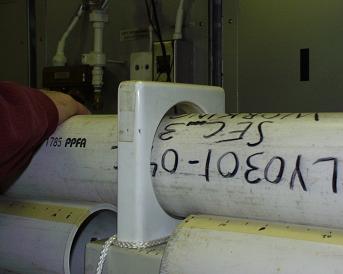 |
Before I went off on the optics tangent, I was explaining about the coring operation. I’d like to finish that story here. After they bring the cores on deck, they must remove the inner PVC pipe that contains the sediment. They then cut the long PVC core into 1.5-meter sections with a pipe cutter. They cap off the ends, and label the top and bottom sections for storage in a refrigerator. These sections probably weigh 100 pounds or more. Chip Heil and Jason Ressler, both graduate students at the University of Rhode Island (URI), are now presently analyzing the contents of the cores for magnetic strength. This they hope will tell them the origin of the sediment. High magnetic susceptibility might indicate a period of increased erosion of continental rocks (terrigenous), whereas low susceptibility may be more indicative of a time when biogenous material comprises most of the sediment. So these cores will tell them the depositional environment, including source material and possible transport mechanisms from thousands upon thousands of years ago. But how can they get accurate magnetic field measurements through these PVC pipes? Enter electricity to the rescue. |
| Did you ever wonder where electricity comes from? How do you make electricity? One way is with magnets and a lot of wire. Hydroelectric plants store the energy of water behind large dams. They allow some water to flow through the dams, and this water exits the dam at a much lower height. The gravitational potential energy lost is converted into kinetic energy of motion (to turn big turbines) and thermal energy. The turbines are connected to large coils of wire that rotate in a magnetic field produced by huge permanent magnets. A loop of wire rotated within a magnetic field causes charges to move, creating electric current. A moving magnet in a coil of wire will also induce an electric current. Similarly, a changing current will induce a magnetic field. Hence, electricity and magnetism are related to each other. This is how electromagnets work. Junkyards use these all the time. They turn on the electric current through a large coil of wire, creating a very strong magnet. So strong, that they can pick up automobiles via a crane. They position the car to where they want to drop it, and they turn off the current. Walla! |
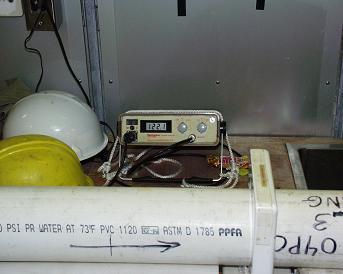 |
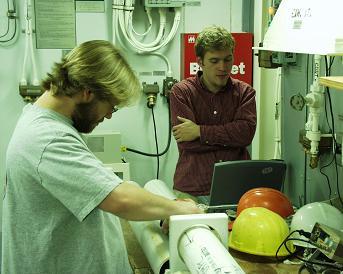 |
Chip and Jason use this idea to determine the magnetic properties in their core. Fig 1 shows the apparatus, which is just a coil of wire inside the plastic housing. Fig 2 shows the power supply that controls the frequency of the current and its strength. Fig 3 shows Chip and Jason working together to position the core sample between the coils of wire. They move the core in 2 cm intervals, press a button on the laptop computer to initiate the readings, and in 10 seconds the computer records the magnetic susceptibility. They then move the core another 2 cm, and the process is repeated for the entire length. Fig 4 is a printout of the magnetic susceptibility for the first meter of a core. Possibly, the large change that occurred near the 100 cm mark could represent the transition from the last glacial to the present interglacial period, which dates back 10,000-20,000 years. Knowing the core depth and the approximate age, this would imply a sedimentation rate of the order of 1-2 cm per every 100 years. This is probably in the right order of magnitude. These results have to be more carefully analyzed back at URI, and correlated with other paleoclimate proxies like O18 ratios. However, they are excited about their data and the opportunity to present their eventual findings to the oceanographic community. |
| On a side note, Chip told me that during high school, he didn’t really enjoy physics class. That “cut-right-into-my-heart”, but then he redeemed himself to me by saying, “but now I use it all the time”. These core samples he analyzes he can position in 3 dimensions. So he uses vectors and components of force vectors daily. |
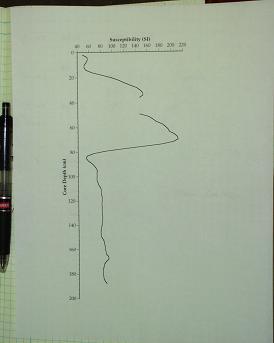 |
Iceberg alley
Gerhard Behrens |
| Many people hear the word iceberg and think about the Titanic. Well, we are in the exact place where that kind of an iceberg started and where thousands of icebergs roam each year. Last night, as we moved toward the west coast of Greenland, we were almost surrounded by them. This afternoon, at one point, there were over 60 around the ship. The stretch of water we have passed through in the last two weeks is known as Iceberg Alley because there are some many floating around. |
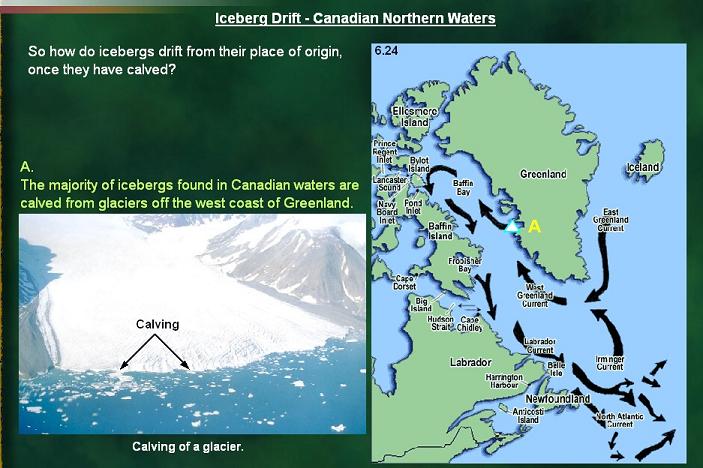
Iceberg calving and iceberg flow in Baffin Bay. |
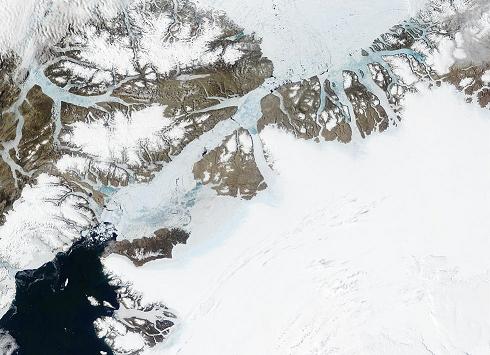
Greenland’s glaciers from the air |
Look at the map to see how the currents in Baffin Bay carry the icebergs. They travel up the coast of Greenland on the West Greenland Current and down the coast of Baffin Island on the Baffin Current. They glide past Labrador and Newfoundland on the Labrador Current. They can meet passenger or cargo ships in the North Atlantic Current. |
| I had to learn a few things about icebergs.
First, they are often called bergs.
Second, they have to be at least 5 meters (about 15) above sea level.
Third, icebergs break off from glaciers. That is called calving.
Fourth, they are 100% fresh water, nothing salty or seawater about them since they come from glaciers, which are made from rain and snow. Look at the airplane views of Greenland. The glaciers are the white fingers of ice going down to the dark blue water. In the other picture, you can see how glaciers can flow into the ocean before they break off.
Fifth, bergs come in special shapes with special names. Check out the pictures and names on the following charts. |
| Iceberg charts and information are courtesy of Ed Hudson, Meteorological Service of Canada and Yves Sivret, Canadian Ice Service. Additional iceberg photos courtesy of Scott McAullife. Get even more information and pictures at http://ice-glaces.ec.gc.ca. |
| You can see more of the icebergs we have met so far by clicking Pictures, then Places Along the Way, then scrolling down to icebergs. Go the Fun Facts page to get more information and pictures about bergs. |
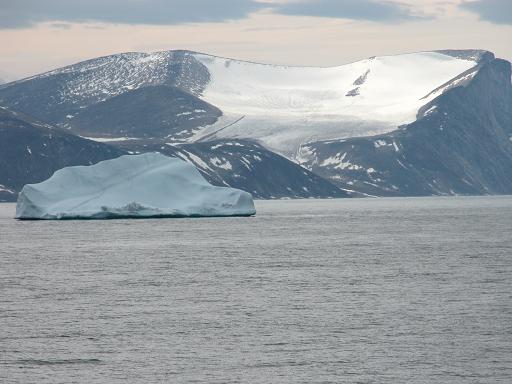
The Healy’s pet icebergs |
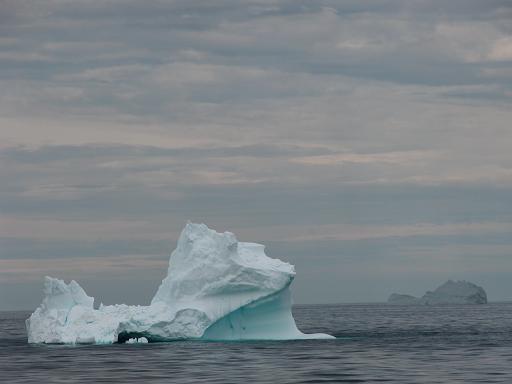 |
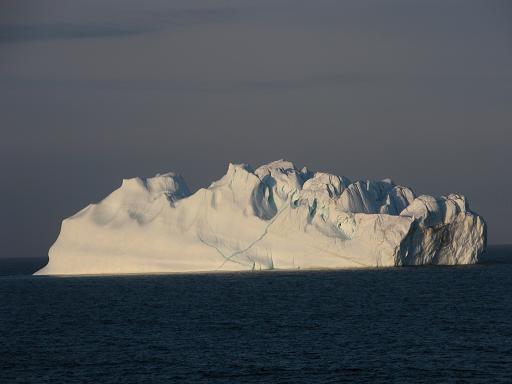 |
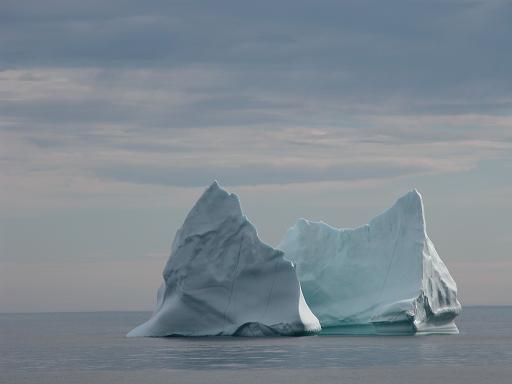 |

Iceberg sizes and names. |
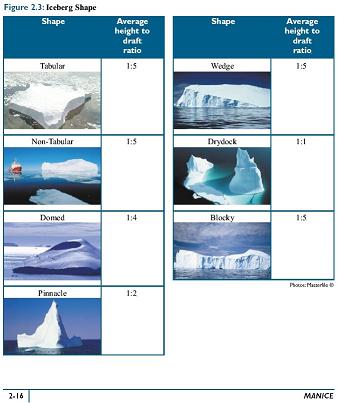
Iceberg shapes and names. |
